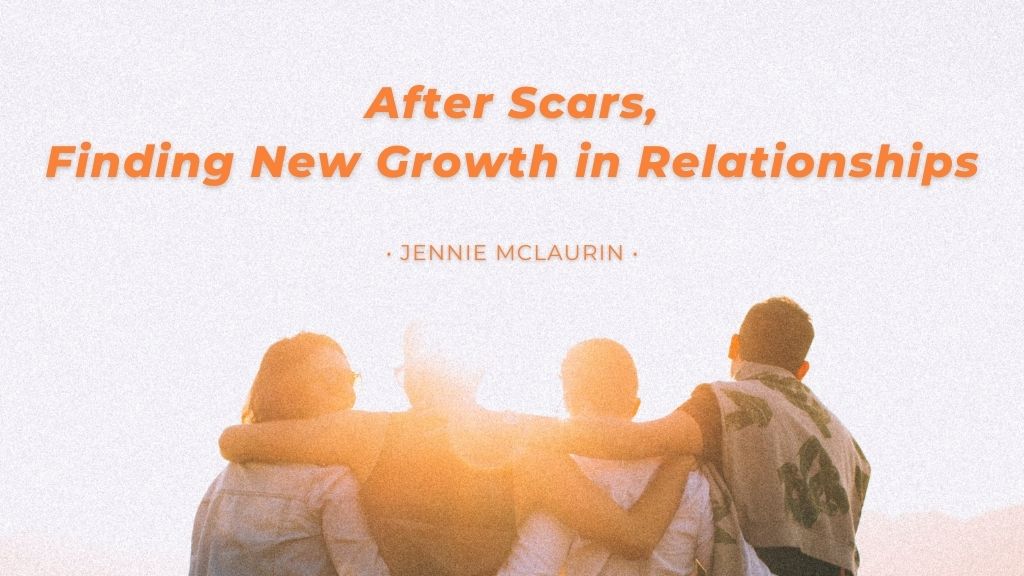After Scars, Finding New Growth in Relationships

“The soul-satisfaction you find in Me
helps you relate well to other people.”
– Jesus Always, July 25
The daily news is full of hopeful images showing us that community gatherings are back. We’ve been through a long season of isolation, and now doors are opening again. What will we choose from as we survey the banquet of opportunities laid before us? Will we finally be able to resume life as we knew it?
We rejoice as we are allowed to join in worship, hug our loved ones, and enjoy a meal with friends. It is indeed good to do life together. But before we settle for a return to our former ways, let’s consider that this new entry into community may be a call to go further toward real restoration, rather than simple resumption, of relationships.
The irony is, while the news highlights the sorrows of isolation due to the pandemic, it also broadcasts the toxic effects of our unhealed lesions with one another. Societies, churches, and families struggle with overcoming severed connections. Perhaps, in this era of attention to how disease affects our bodies, we can also better understand how God designs us to heal from our wounds.
God’s Design For Healing
The human body is created with a tremendous capacity for recovery and restoration after injury. For reasons we can’t fully understand, we are not made as invincible superheroes but as people susceptible to trauma. Instead of preventing us from facing afflictions, God designed us to experience processes of healing and renewal. Those processes are more of a superpower than most of us realize.
Within seconds, the body reacts to a fresh wound by forming a clot. No time is wasted as platelets are called to gather and form a sticky fibrin mesh, plugging leaky blood vessels and staying close to the problem site. The clot’s rapid defense then signals other blood cells to take up their roles.
Inflammation happens next—some pain and irritation are necessary as these cell types clear up wound debris, cleaning the site to prevent infection. They apply pressure to the wound, but in moderation—too much pressure destroys good tissue. When just enough inflammation occurs, it allows new tissue growth to begin.
The Beauty of Renewal
New tissue growth is a beautiful, complex, coordinated event that draws from a diverse group of body members. A healing matrix is formed, a scaffolding for building just what is needed at that particular location in the body. Nerves, muscles, and blood vessels take shape under the oversight of the healing matrix, forming without our conscious efforts. Most of us don’t consider how incredible it is to see a badly scraped knee transition to a patchy pink spot of new flesh. But it is something beyond our ability to invent ourselves.
At the end of the healing process, a scar binds the injury to healthy tissue. We get on with life, despite the visible reminders of past hurts. Healthy scars don’t impair us, but are carried with us as part of our life story.
Most of us yearn for new tissue to grow in the deep divisions of our lives. We want to prevent new injuries from becoming chronic places of inflammation. As the body is designed to give full energy toward flourishing and renewal, so may we do the same in our gathered bodies.
How Can You Help Others To Heal?
Maybe you are quick to notice another’s hurt, leaning in and helping to stop the bleeding like a clot. Clots don’t have time to give advice—their presence is what matters. Maybe your gifts resemble the healing process of inflammation. You help clean up a mess, speak truth, and clear confusion, using just the right measure of influence so you don’t damage what is healthy.
All healing in the body requires community effort. Might we allow the Spirit to lead us in building a healing matrix for new life together? Jesus calls us to lovingly lay down and take up our lives with one another—new growth then forms to fit the current space. The shape may differ from the old one, but we may trust that it makes sense for future function. Scars will show, but they can point to restoration rather than rupture.
We are called the body of Christ. May we be called to more than life as we knew it.
About The Author
 Jennie A. McLaurin is a writer and a physician with degrees in medicine, public health, and theology. Her book, Designed to Heal: What the Body Show Us about Healing Wounds, Repairing Relationships, and Restoring Community (coauthored with Cymbeline T. Culiat), releases in August 2021.
Jennie A. McLaurin is a writer and a physician with degrees in medicine, public health, and theology. Her book, Designed to Heal: What the Body Show Us about Healing Wounds, Repairing Relationships, and Restoring Community (coauthored with Cymbeline T. Culiat), releases in August 2021.

